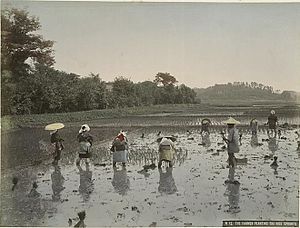Chichibu incident

The Chichibu incident (秩父事件, Chichibu jiken), also known as Chichibu revolt, was a large-scale peasant revolt in November 1884 in Chichibu, Saitama, a short distance from Japan's capital. It lasted about two weeks.
It was one of many similar uprisings in Japan around that time, occurring in reaction to the dramatic changes to society which came about in the wake of the 1868 Meiji Restoration.[1] What set Chichibu apart was the scope of the uprising, and the severity of the government's response.
Background
After the end of the

This situation was worsened by the
The rising discontent of the farmers (農民, nōmin) led to a number of
A number of these uprisings were organized and led through the "
Uprising
While many groups and political parties across the country debated political issues peacefully, the self-titled "Revolutionary Army" erupted in revolt on 31 October 1884, in the Chichibu district of Saitama Prefecture. The uprising was triggered by the refusal of creditors to allow a moratorium on repayment of loans. The insurgents sought to attack a government building and loan shark offices and to destroy records of their debts.
Accounts of the size of the revolt varied widely, from 5,000 to over 10,000 men. Most of the rebels were armed with farming implements, bamboo spears, swords, wooden cannon, and hunting muskets. The rebels poured out of their small mountain villages, armed not only with weapons, but with banners and slogans; declaring "New Rule of Benevolence," and labeling the seized district office as the "Headquarters of the Revolutionary Army."[4]
Having established a headquarters, the ringleaders adopted a new calendar, and began to issue decrees, labeling all as being issued in "Year One of Freedom and Self-Government." The revolutionaries also dispatched smaller groups to seek out and oust individual government officials in the neighboring villages before recalling their forces and marching toward Tokyo, where the movement first met with significant resistance.[5]
The revolutionaries were met by the
Although this was the largest popular uprising of the Meiji period, or perhaps because of it, the government sought to dismiss it by describing the rebels as little more than hooligans.
Legacy
Overall, the Chichibu Incident was caused by a combination of liberal, revolutionary ideologies and economic motivations. Though the traditional view of the event reduces the peasants' motivations to being purely economic, some scholars see it as part of a suppressed peoples' rights movement in this period.
Though a monument to the fallen was erected several decades later, a great number of the ringleaders and others who escaped formal punishment have never had their names officially cleared. A film, Kusa no Ran, appeared in 2004, directed by Seijirō Kōyama, commemorating the incident's 120th anniversary.
Some locals in Chichibu claim that the peasant revolt was the inspiration for the fictional setting of Titipu in the British comic opera The Mikado, while others suggested that the opera's librettist, W. S. Gilbert, was inspired by seeing kimonos made from Chichibu silk.[6] In March 10, 2001, The Mikado was first performed in Chichibu by a cast of local actors.[7]
Notes
- ^ Bowman, Columbia Chronologies of Asian History and Culture. p. 167
- ^ Howell, Geographies of Identity in Nineteenth Century Japan. Pp.109
- ^ Irokawa Daikichi, The Culture of the Meiji Period. Pp.155
- ^ Tierney, Kamikaze, Cherry Blossoms and Nationism. p. 81
- ^ McCain. Japan:A Modern History. Pp.118
- ^ Brooke, James. "Japanese Hail The Mikado, Long-Banned Imperial Spoof", The New York Times, April 3, 2003
- ^ Sumiko Enbutsu: The Mikado in the Town of Chichibu Archived February 20, 2012, at the Wayback Machine
References
- Bowman, John (2000). Columbian Chronologies of Asian History and Culture. Columbia University Press. ISBN 0-231-11004-9.
- Howell, David L. (2005). Geographies of Identity in Nineteenth-Century Japan. University of California Press. ISBN 0-520-24085-5.
- Irokawa, Daikichi (1985). The Culture of the Meiji Period. Princeton: Princeton University Press. (Marius Jansentrans. ed.)
- McCain, James L (2001). Japan: A Modern History. WW Norton & Son. ISBN 0-393-04156-5.
- Tierney, Emiko Ohnuki (2002). Kamikaze, Cherry Blossoms, and Nationalisms: The Militarization of Aesthetics in Japanese History. University of Chicago Press. ISBN 0-226-62091-3.
